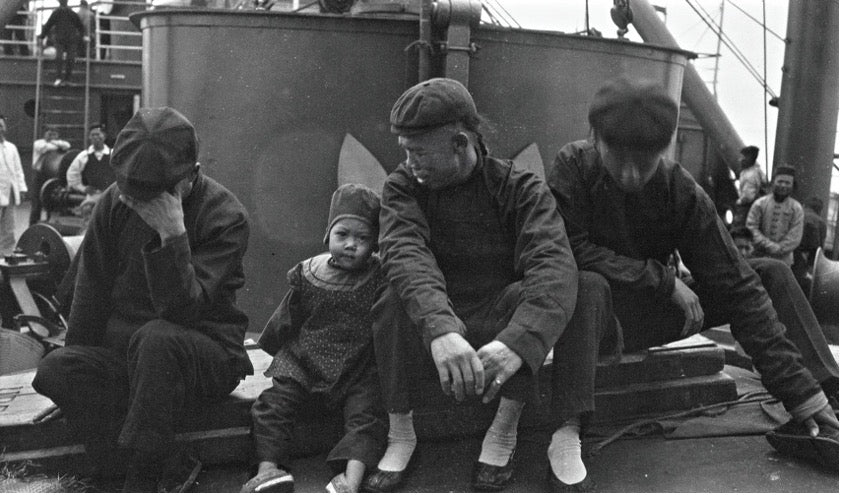Something that you might not know about Jack London is that apart from being one of the most influential American writers of the 20th century, he was also a photojournalist, socialist and more importantly a prolific photographer, capturing his surroundings on the various adventures and travels he embarked on throughout his life.
There are roughly 12,000 photographs of his (archived in the Huntington Library in California) that bear witness to a particular proximity to the people and places that he encountered. When you look at some examples more closely, and specifically the photographs he took of people, you can tell that the camera angle is not positioned from above or far away (as an observer might look at the scene).
 ‘Fire!’ Korea, 1904
‘Fire!’ Korea, 1904
Rather, Jack London took on the role of an equal to the people he photographed by lowering himself and his camera to their level and inserting himself into their reality. As a matter of fact, London shared this style of photography with a small San Francisco-based group of art photographers whose work – “based on the clear and unadorned expression of what was before the lens” – would influence American fine art photography for years to come.
 Passengers on the S.S. Siberia en route to Yokohama, Japan, 1904
Passengers on the S.S. Siberia en route to Yokohama, Japan, 1904
Now, this might sound obvious, but a person with multiple skills is bound to translate and use one of their skills across their other lines of work. And it is in his writing that we find Jack London (perhaps unconsciously so) portraying the world with a photographic lens.
 Whitechapel on a bank holiday, London, 1902
Whitechapel on a bank holiday, London, 1902
We can recognize the proximity to his ‘subjects’ from his 'photographs' in The Call of the Wild. The novel contains some passages that almost feel as if the author were taking a picture of what he is describing; his skill as a photographer clearly shines through in these scenes. See for example this passage describing Buck:
“A carnivorous animal, living on a straight meat diet, he was in full flower, at the high tide of his life, overspilling with vigour and virility. When Thornton passed a caressing hand along his back, a snapping and crackling followed the hand, each hair discharging its pent magnetism at the contact. Every part, brain and body, nerve tissue and fibre, was keyed to the most exquisite pitch; and between all the parts there was a perfect equilibrium or adjustment.”
Scholars in the field of 20th century American literature have categorized London’s writing style as naturalist and realist. This means that the descriptions of objects, places and situations is almost scientific in its detail and precision. This is not surprising knowing he was a socialist and photographer. One of the goals of realist writers like London was to analyze physical (fictional) surroundings to explain the causes of certain phenomena and in turn to also exercise social criticism.
The human being who is rooted in his natural environment and therefore inextricably linked to and intertwined with nature is the subject of naturalist literary explorations. And indeed, when we look at the author as an individual who has multiple skills, it seems natural (pun not intended) that we can almost seize Jack London’s photography through his writing.

The dog Jack that inspired Buck in ‘The Call of the Wild’ with the Bond brothers in Dawson City, Yukon Territory Canada, ca. 1896-98
For instance, Buck, the dog-hero of the story, becomes alive throughout the pages of the book, almost as if he were human.
“His muscles were surcharged with vitality, and snapped into play sharply, like steel springs. Life streamed through him in splendid flood, glad and rampant, until it seemed that it would burst him asunder in sheer ecstasy and pour forth generously over the world.”
If we read this passage without the context of the novel, we would be fairly certain it was describing a human being rather than a dog. This method of anthropomorphism—the process through which an animal gains human-like features—is a literary tool frequently used by naturalist writers because it breathes life into the story that describes natural environments and animal characters.

Promotional photograph of Strongheart the dog
Going further, we might say that Jack London’s entire novel and his exploration of the life of a marginal being in our society (animals not being considered as valuable as human beings) points towards a broader criticism of the exploitation of weaker members of society.
Do you agree? Let us know in the comments.
- Laura
P.S. Thanks for reading my first letter for Century Press! You can pick up a copy of our limited edition of Jack London's The Call of the Wild here.
For more information about the life of Jack London, I recommend you watch the short documentary series Jack London : An American Adventure, or read this article.
You can also flip through London’s photographs on the website of the Huntington Library, where they have been archived.

Laura: Thanks for the interesting piece. It brought to mind “shape shifters” – a concept associated with Indigenous cultures and their human-animal relationships. Maybe London was shape shifting from his person to Buck and back. While in Canada, maybe you’ll have the opportunity to look into it further.
Lovely informative piece Laura…..good luck with Century Press and school in Ottawa…..welcome to Canada!
Leave a comment